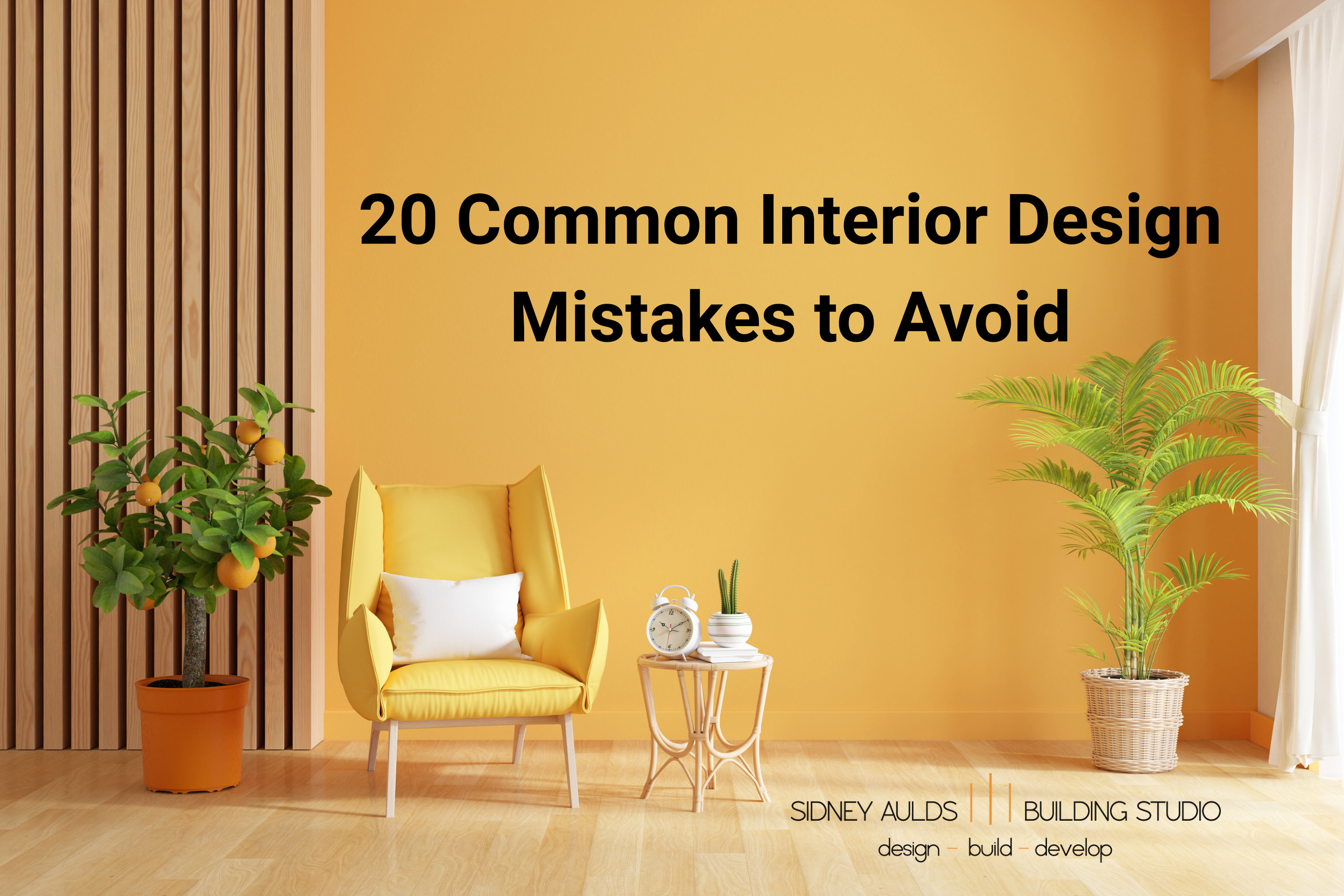20 Common Interior Design Mistakes to Avoid (According to a Denver Architecture Firm)
Over the years at Sidney Aulds Building Studio, I’ve had the opportunity to walk into a lot of homes - some newly built, some mid-renovation, and some in need of a serious design rescue. And if there’s one thing I’ve learned, it’s this: even the most beautiful structure can fall flat without thoughtful interior design.
Today, I’m sharing 20 common interior design mistakes I’ve seen repeatedly on client projects. If you’re planning, renovating, or just tweaking your space, keep these in mind to avoid frustration and costly redos.
1. Choosing Paint Colors Before Anything Else
Too often, I see clients start with a wall color, then struggle to match their furniture, flooring, or textiles to it. Start with your key furnishings and fabrics first. The wall color is the easiest thing to customize at the end.
2. Furniture That’s Out of Scale
From sofas that swallow a living room to tiny coffee tables that look lost, scale matters. Measure your room and furniture. Balance large items with lighter pieces, and leave space for flow.
3. Relying on a Single Light Source
Relying solely on overhead lighting makes a room feel flat and cold. I see this mistake in many newly built homes. Layer lighting with floor lamps, sconces, and pendant lights to create depth and warmth.
4. Hanging Art Too High
It’s surprisingly common. Artwork that’s hung too high loses its visual impact. Art should be hung at eye level, typically 57 to 60 inches from the floor to the center of the piece.
5. Neglecting the Ceiling
Ceilings are often ignored, but they’re a design opportunity, especially in custom homes. Use ceiling treatments like beams, coffered panels, bold paint, or wallpaper to add personality.
6. Underestimating Rug Sizes
A rug that’s too small makes a room feel incomplete. This is one of the top issues I see in living areas. Rugs should extend under all front legs of your furniture. In dining rooms, the rug should fit all chairs, even when pulled out.
7. Pushing All Furniture Against the Walls
In an attempt to open up space, many people shove furniture to the edges. Float furniture to create conversation zones. Even in small rooms, a more central layout feels intentional and cozy.
8. Ignoring Traffic Flow
I’ve walked through homes where furniture arrangement turns simple movement into a maze. Leave at least 30 to 36 inches of walkways. Prioritize clear paths between doors and around furniture.
9. Over-accessorizing
More isn’t always better. When I visit homes cluttered with decor, it distracts from the overall design. Be selective. Leave some surfaces clear, and rotate decor items seasonally to keep things fresh.
10. Not Enough Storage Solutions
Clients often complain about clutter, but the real issue is a lack of thoughtful storage. Integrate built-ins, hidden storage, or dual-purpose furniture like ottomans with compartments.
11. Buying Matching Sets
It’s tempting to buy full furniture sets, but it results in a cookie-cutter look. Mix materials, finishes, and silhouettes. A collected, curated look feels richer and more personal.
12. Too Many Trends at Once
I’ve had clients who want mid-century modern, industrial, and farmhouse all in the same space. Choose one or two design influences. Use trendy items as accents, not foundations.
13. Poor Window Treatments
Too short or narrow curtains make windows feel stunted. Hang curtains higher, close to the ceiling, and wider than the window to give the illusion of height and space.
14. Forgetting the Floor Plan
Sometimes homeowners design room by room without a cohesive layout. The result feels disjointed. Work with your architect or designer on a holistic layout. Think about how each room connects and communicates.
15. Ignoring the Power of Texture
I’ve seen beautiful homes feel cold because everything is sleek or smooth. Add warmth with a mix of materials like linen, wood, stone, metal, leather, and woven fabrics.
16. Inconsistent Color Temperature in Lighting
Cool LED bulbs in one room, warm tones in another, it throws off your entire aesthetic. Choose one color temperature for all bulbs in common spaces. I usually recommend warm white, around 2700K to 3000K, for a cozy vibe.
17. Lack of a Focal Point
Rooms without a visual anchor feel chaotic. Create a focal point, a fireplace, statement art, or built-in shelving, and build the rest of the room around it.
18. Skipping Test Swatches
One of the simplest things clients forget is testing samples in real light. Always test paint, tiles, and fabrics in your home’s natural and artificial light before committing.
19. Designing Without a Plan
Impulse buys and Pinterest inspiration overload can lead to mismatched chaos. Start with a mood board or design brief. Define your goals, color palette, and furniture needs before shopping.
20. Overlooking Personal Style
I’ve seen clients design for resale or guests and end up not enjoying their own space. Design for you. Include art, colors, and materials that reflect your personality and story.
Final Thoughts
As an Architect and real estate developer, I’ve always believed that a home should do more than just look good; it should feel good to live in. Interior design is the soul of the structure. When done thoughtfully, it enhances your daily routines, supports your lifestyle, and reflects your identity.
Avoiding these 20 common interior design mistakes can transform your space from frustrating to fulfilling. If you're building new construction or updating a current home, we're here to help you create spaces that work beautifully from the inside out.
Want to start your dream project? Contact Sidney Aulds Building Studio and let’s build something intentional together.







